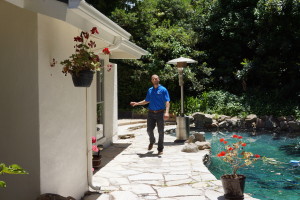New 2018 Legislation Adds Liability to Inspectors, Realtors
California SB 422 – Pool Safety Act
As if selling real estate didn’t have enough liability, it has now become part of a home inspection to check certain safety features of a pool no matter what. If your home inspector is not certified, insured, or accustomed to inspecting swimming pools it could transfer extra liability onto the Realtors and sellers if someone becomes injured or drowns.
Starting January 1st, 2018, a new requirement was added to the California Business and Professional Code 7195 which  regulates home inspections. AB 422 adds a requirement that all homes sold that have a pool, including spas and portable spas, must now be evaluated for the presence of certain safety features to prevent drownings.
regulates home inspections. AB 422 adds a requirement that all homes sold that have a pool, including spas and portable spas, must now be evaluated for the presence of certain safety features to prevent drownings.
Prior to the passage of SB 422, residential pools built before 1997 that have not undergone a significant remodel since 2007 were not required to install any drowning prevention safety features, and the findings of the 2006 Pool Safety Act suggest that as many as one million pools were constructed in California before the first drowning prevention requirements went into effect in 1997. In 2016, a version of this bill attempted to extend the Act’s protections by requiring pools to be brought into compliance at the time of a property sale.
In response to concerns cited by the California Association of Realtors, the author of the Bill took amendments to remove this requirement. Rather than making pre-1997 pools comply with the Pool Safety Act when they are sold, this year’s version of the bill imposes minor changes to the existing home inspection process intended to inform prospective homebuyers whether a property’s pool is equipped with safety features that meet the standards in current law. This makes use of the transfer of the home as an educational opportunity without imposing additional requirements on pool owners (sellers).
A minimum evaluation of pool safety features will be added to all full home inspections performed by The Real Estate Inspection Company. We are certified, insured, and experienced pool inspectors. If you are involved with the purchase of a house with a pool, consider getting a full pool inspection for the safety of your family.
Relevant Test of Bill:SEC. 3.
Section 7195 of the Business and Professions Code is amended to read:7195.
For purposes of this chapter, the following definitions apply:(a) (1) “Home inspection” is a noninvasive, physical examination, performed for a fee in connection with a transfer, as defined in subdivision (e), of real property, of the mechanical, electrical, or plumbing systems or the structural and essential components of a residential dwelling of one to four units designed to identify material defects in those systems, structures, and components. “Home inspection” includes any consultation regarding the property that is represented to be a home inspection or any confusingly similar term.
(2) In connection with the transfer, as defined in subdivision (e), of real property with a swimming pool or spa, an appropriate inspection shall include a noninvasive physical examination of the pool or spa and dwelling for the purpose of identifying which, if any, of the seven drowning prevention safety features listed in subdivision (a) of Section 115922 of the Health and Safety Code the pool or spa is equipped.
Due to the sheer number of injuries and drownings, home inspectors are now required to identify the presence of at least two safety features that are now required on new pools.
SEC. 4.
Section 115922 of the Health and Safety Code is amended to read:115922.
(a) Except as provided in Section 115925, when a building permit is issued for the construction of a new swimming pool or spa or the remodeling of an existing swimming pool or spa at a private single-family home, the respective swimming pool or spa shall be equipped with at least two of the following seven drowning prevention safety features:
(1) An enclosure that meets the requirements of Section 115923 and isolates the swimming pool or spa from the private single-family home.
(2) Removable mesh fencing that meets American Society for Testing and Materials (ASTM) Specifications F2286 standards in conjunction with a gate that is self-closing and self-latching and can accommodate a key lockable device.
(3) An approved safety pool cover, as defined in subdivision (d) of Section 115921.
(4) Exit alarms on the private single-family home’s doors that provide direct access to the swimming pool or spa. The exit alarm may cause either an alarm noise or a verbal warning, such as a repeating notification that “the door to the pool is open.”
(5) A self-closing, self-latching device with a release mechanism placed no lower than 54 inches above the floor on the private single-family home’s doors providing direct access to the swimming pool or spa.
(6) An alarm that, when placed in a swimming pool or spa, will sound upon detection of accidental or unauthorized entrance into the water. The alarm shall meet and be independently certified to the ASTM Standard F2208 “Standard Safety Specification for Residential Pool Alarms,” which includes surface motion, pressure, sonar, laser, and infrared type alarms. A swimming protection alarm feature designed for individual use, including an alarm attached to a child that sounds when the child exceeds a certain distance or becomes submerged in water, is not a qualifying drowning prevention safety feature.
(7) Other means of protection, if the degree of protection afforded is equal to or greater than that afforded by any of the features set forth above and has been independently verified by an approved testing laboratory as meeting standards for those features established by the ASTM or the American Society of Mechanical Engineers (ASME).



